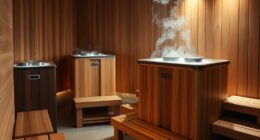Using heat zoning helps you control temperatures in different areas of your home independently, which cuts down on energy waste. By installing multiple thermostats and sealing barriers like doors or curtains, you prevent heat from flowing unnecessarily between zones. This targeted approach keeps each space comfortable while reducing your energy bills. Properly managing airflow and insulation is key to maximizing efficiency. If you want to learn how to set up effective heat zoning, keep exploring the best techniques.
Key Takeaways
- Heat zoning allows independent temperature control to avoid unnecessary heating in unoccupied areas.
- Properly sealed barriers prevent heat transfer between zones, reducing energy loss.
- Strategic thermostat placement ensures accurate temperature regulation and efficiency.
- Targeted heating minimizes system overwork, lowering overall energy consumption.
- Effective zoning enhances comfort while decreasing energy bills through precise control.

Have you ever wondered how to make your home more energy-efficient and comfortable? One effective way is through heat zoning, which allows you to control the temperature in different areas of your house independently. This approach helps reduce unnecessary energy use and keeps your living space more comfortable. The key to successful heat zoning lies in smart thermostat control and the strategic use of zoning barriers.
Heat zoning enhances comfort and efficiency by controlling temperatures independently in different home areas.
When you set up your home for heat zoning, you’ll want to install multiple thermostats in various zones. These thermostats give you the power to manage each area’s temperature separately, ensuring that you’re not wasting energy heating rooms that aren’t in use. For example, you can keep the living room warmer during the day while maintaining a cooler temperature in the bedrooms at night. This precise control minimizes energy waste because your heating system isn’t working overtime to heat unoccupied spaces.
A vital part of heat zoning involves establishing zoning barriers. These barriers are physical or structural elements that separate different zones within your home, preventing heat from flowing freely between areas. Installing doors, curtains, or even specialized insulation can act as zoning barriers, helping to contain the heated air within each zone. When these barriers are in place, your thermostat control becomes more effective because the heat stays where you want it, rather than dissipating into other parts of the house. Proper zoning barriers can significantly improve the overall efficiency of your heating system by reducing heat loss and drafts. Additionally, proper insulation in these barriers further enhances energy savings by maintaining consistent temperatures in each zone. Maintaining the right balance of airflow control is essential to prevent uneven heating and ensure optimal comfort in each zone. This containment reduces the workload on your heating system, leading to lower energy bills and a more consistent temperature in each zone.
To optimize your heat zoning system, you should also consider the placement of thermostats and barriers carefully. Position thermostats in locations that accurately reflect the typical activity and comfort levels of each zone. Avoid placing them near windows, doors, or sources of drafts, as these can give false readings and lead to inefficient heating. Similarly, ensure that zoning barriers are properly sealed and insulated to prevent heat from sneaking into or out of zones. Proper heat zoning techniques enhance the overall efficiency of your system, ensuring that your heating energy is used more effectively and reducing waste. This way, your heating system responds more precisely to the needs of each area, avoiding unnecessary energy consumption.
Frequently Asked Questions
How Does Heat Zoning Impact Indoor Air Quality?
Heat zoning improves indoor air quality by allowing you to control airflow in different areas, enhancing indoor air circulation. This targeted approach helps reduce dust accumulation in specific zones, preventing buildup that can affect air quality. You can adjust zones to improve ventilation, minimize allergens, and maintain a healthier environment. Proper zoning guarantees that fresh air reaches different parts of your home efficiently, making your indoor space cleaner and more comfortable.
Can Heat Zoning Be Integrated With Smart Home Systems?
Yes, you can integrate heat zoning with smart home systems. By using smart thermostats, you can control zoning system compatibility, making it easy to adjust temperatures in different areas via your smartphone or voice commands. This integration allows for seamless automation, energy savings, and personalized comfort. Confirm your zoning system supports smart thermostat integration for smooth setup and ideal performance in your smart home ecosystem.
What Are the Initial Costs of Implementing Heat Zoning?
Sure, the initial costs of implementing heat zoning might make you think twice—it’s not cheap. A thorough cost analysis reveals installation challenges, like upgrading your existing system or adding smart thermostats. While the upfront expense can seem high, you’ll likely save money in the long run through reduced energy waste. So, yes, it’s an investment, but one that pays off with smarter, more efficient heating.
How Does Heat Zoning Affect HVAC System Lifespan?
Heat zoning can extend your HVAC system’s lifespan because it allows you to focus maintenance on specific zones, reducing overall strain. Proper zoning zone selection guarantees your system isn’t overworking, which minimizes wear and tear. Regular zoning system maintenance keeps components in good shape, preventing costly repairs. By effectively managing zones, you help your HVAC operate efficiently, ultimately prolonging its lifespan and maintaining comfort in your home.
Are There Any Legal or Building Code Considerations?
You need to check building permits and zoning regulations before installing heat zoning. Local codes may require permits or have specific requirements for zoning modifications. Failing to obtain necessary permits could lead to fines or future legal issues. It’s crucial to consult your local building department to make sure your heat zoning complies with all legal and zoning regulations, helping you avoid penalties and ensuring your system operates smoothly within the law.
Conclusion
By implementing heat zoning, you can cut your energy waste considerably—up to 30%, according to recent studies. Imagine only heating the rooms you use daily, saving both money and the environment. This targeted approach not only lowers your bills but also reduces your carbon footprint. So, consider dividing your home into zones and controlling each separately. It’s a simple change that makes a big difference, helping you stay warm while wasting less energy.











